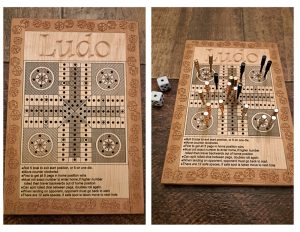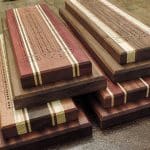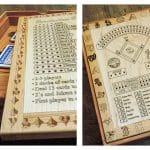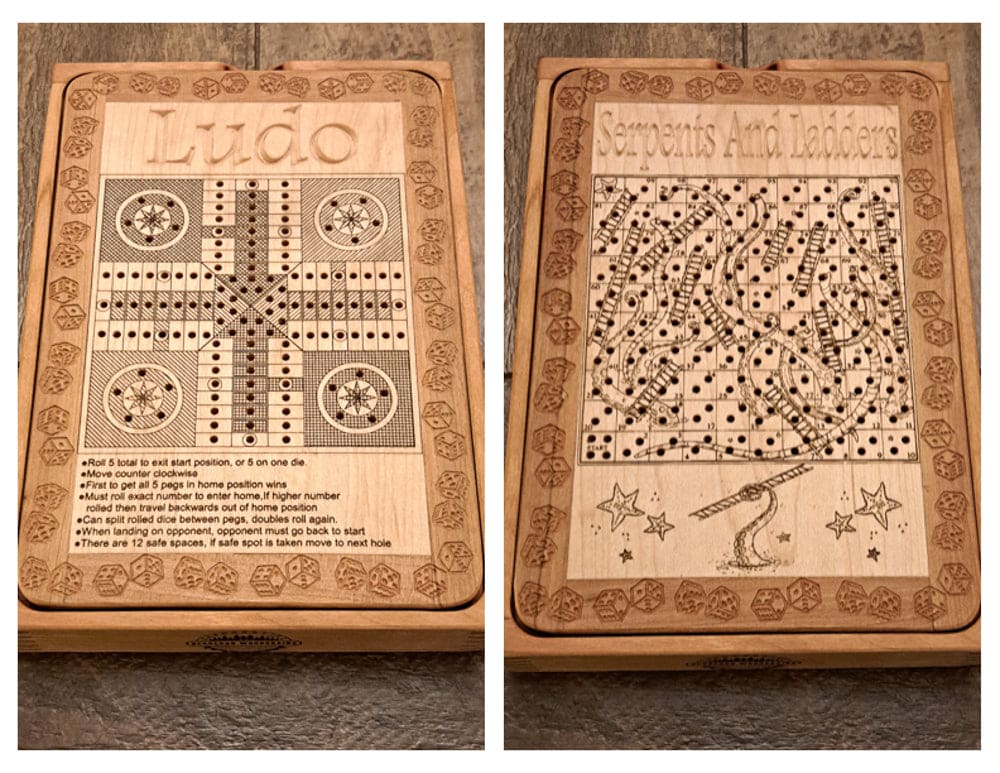Free Shipping On Orders Over $150 To Canada And US
Ludo Rules
Ludo Rules
Ludo is a game for 2-4 players. It requires a multi-coloured/patterned board, 20 playing pieces, and two dice.
Game Play:
If only 2 players are playing, you should sit opposite of your opponent. Each player picks a Pattern, and takes the five playing pieces(pegs). Place your pegs in the circle to your right. This is your ‘starting point’.
To move your pegs, you must first enter them onto the track by throwing a ‘5’. This can be singular die, or as a combination of the numbers thrown on both die. Rolling a ‘2 and 3’ or ‘4 and 1’ allows you to move one piece from your ‘starting point’ onto your patterned spot (indicated by an arrow from your ‘starting point’). If you roll a 5 on one die, but not on the other, you will use the second die to move a piece that has entered play, including the piece just entered. If you roll two 5s, move two pieces from your ‘starting point’, if present.
Once a piece has entered play, roll of the die determines how many spaces a piece may move. Pieces move counter clockwise. Die may be combined to move one piece, or may be used separately to move separate pieces, but you may not split a singular die to move two pieces.
Moving pieces into play from the ‘starting point’ takes precedence over moving pieces around the board. If you throw a ‘5’ and you have pieces on your ‘starting point’, you must enter those pieces into play. If your patterned space is blockaded, and you have a piece that must be entered into play, you lose your turn.
If you throw doubles, including 5’s, you immediately take another turn. The only time you do not take a second turn is if you are unable to move your pieces the total number of spaces indicated by the die you rolled. Some people opt to penalize for rolling doubles 3 times in a single turn. You may have that player immediately lose their turn or return their last piece moved to the ‘starting point’ (provided it did not just move ‘Home’.)
Safe Spaces and Capturing Pieces:
All circled spaces are safety spaces, and no piece can be captured while on a circled space. The only exception to this is if an opponent’s piece sits on your patterned circled space. If you must move a piece into play, and your opponent has a piece on your patterned circle spot, you capture that piece. If your opponent is on a circled space, you cannot land on the same circled space. You must place your piece into the next hole.
If you are able to stop the movement of your piece by exact count on a space that your opponent is on, you have captured that piece. That piece is returned to your opponent’s ‘starting place’ and must re-enter play as in the beginning of the game.
You may never move your pieces onto an opponent’s patterned path, so this is also a safe space. Your patterned path is the path to the left of your ‘starting point’, directly in front of you on the board.
Blockades:
Two pegs of the same color that have stopped (by exact count) on the same space as one of your own pegs, must be moved to the next hole (including your ‘starting space’) forming a blockade. No pieces may pass this blockade, including your own. You must move spaces equal to the die roll on each turn, if able. You can leave a blockade in place until you cannot move any other pieces, but you must break the blockade if you have no other moves.
Winning the Game:
To win the game, be the first to move all your pieces to the center ‘Home’ square. A piece only enters the ‘Home’ square by exact count. If you are 2 spaces from the ‘Home’ square and roll a 4 and 5, you cannot move that piece.





